An Evaluation of the NHS Leadership Development Programme: LSBM102
VerifiedAdded on 2023/01/11
|15
|5000
|65
Report
AI Summary
This report presents an evaluation of a leadership development programme from the NHS Leadership Academy, focusing on the Elizabeth Garrett Anderson Programme. It begins with a discussion of leadership and management theories, contrasting transformational and transactional leadership styles, and highlighting the differences between leaders and managers. The report then analyzes the NHS program, assessing its eligibility criteria, course structure, training methods, intended outcomes, and benefits for both individuals and the organization. The evaluation aims to provide a comprehensive understanding of the program's effectiveness in developing senior leaders and its impact on organizational success, offering insights into leadership development within the healthcare sector. The report concludes with a summary of the findings and references.
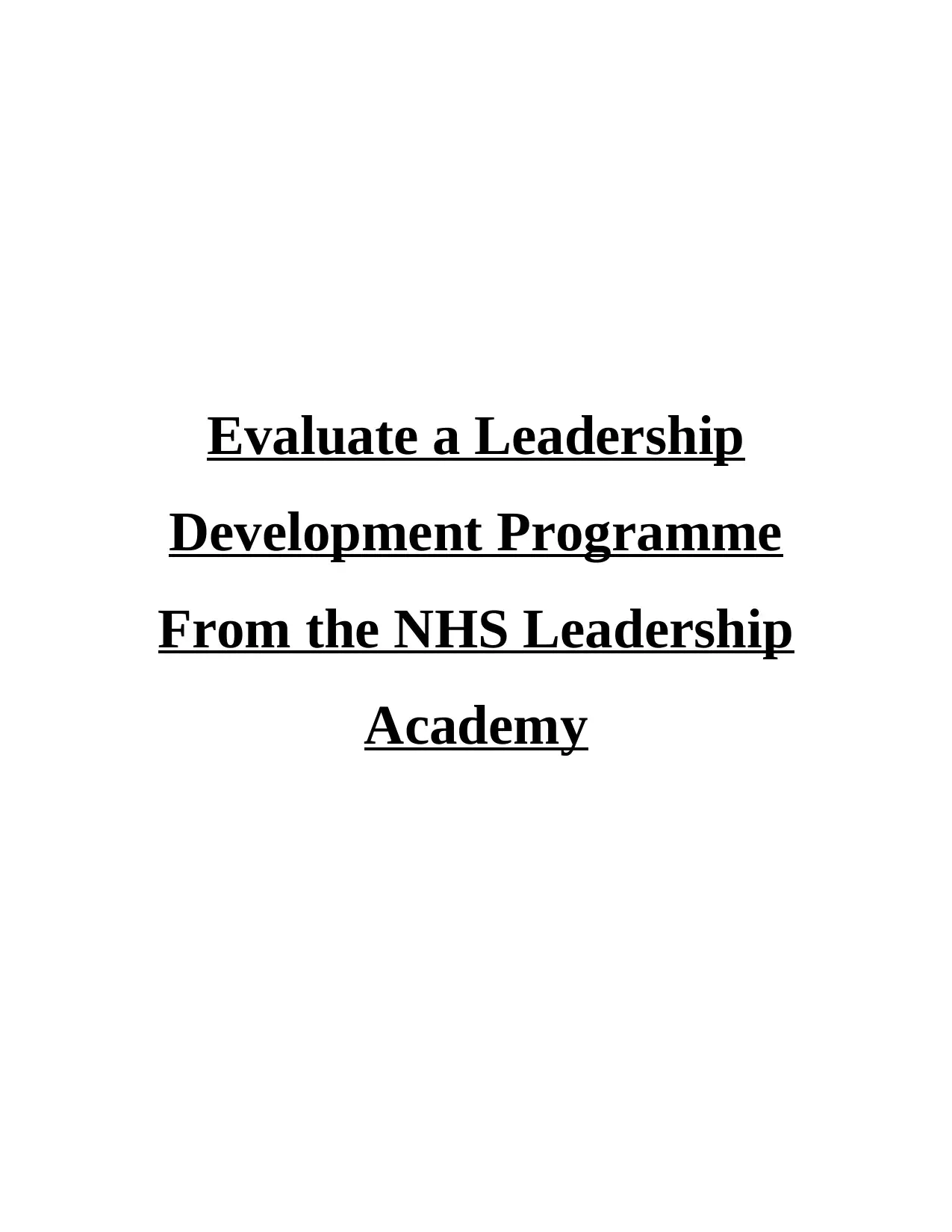
Evaluate a Leadership
Development Programme
From the NHS Leadership
Academy
Development Programme
From the NHS Leadership
Academy
Paraphrase This Document
Need a fresh take? Get an instant paraphrase of this document with our AI Paraphraser
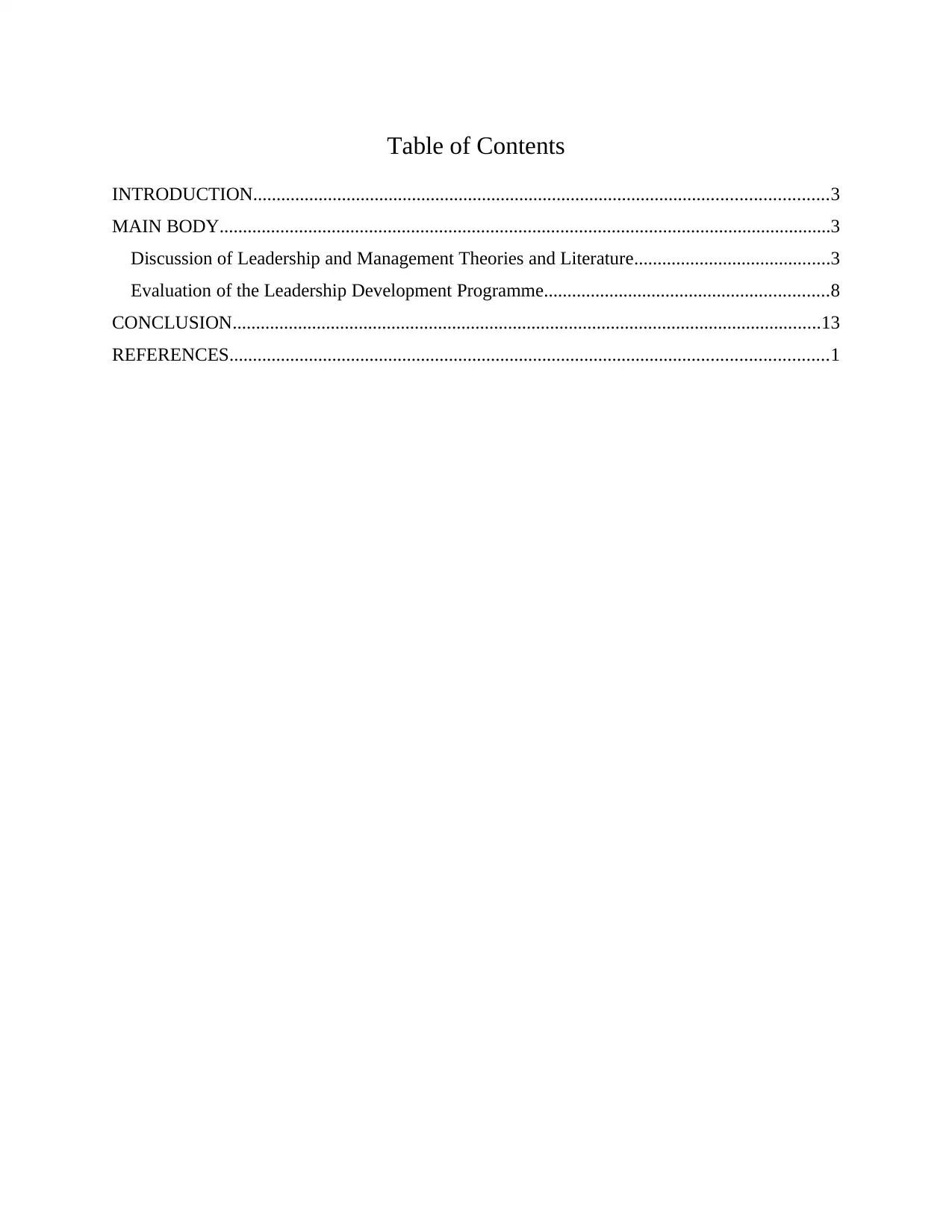
Table of Contents
INTRODUCTION...........................................................................................................................3
MAIN BODY...................................................................................................................................3
Discussion of Leadership and Management Theories and Literature..........................................3
Evaluation of the Leadership Development Programme.............................................................8
CONCLUSION..............................................................................................................................13
REFERENCES................................................................................................................................1
INTRODUCTION...........................................................................................................................3
MAIN BODY...................................................................................................................................3
Discussion of Leadership and Management Theories and Literature..........................................3
Evaluation of the Leadership Development Programme.............................................................8
CONCLUSION..............................................................................................................................13
REFERENCES................................................................................................................................1
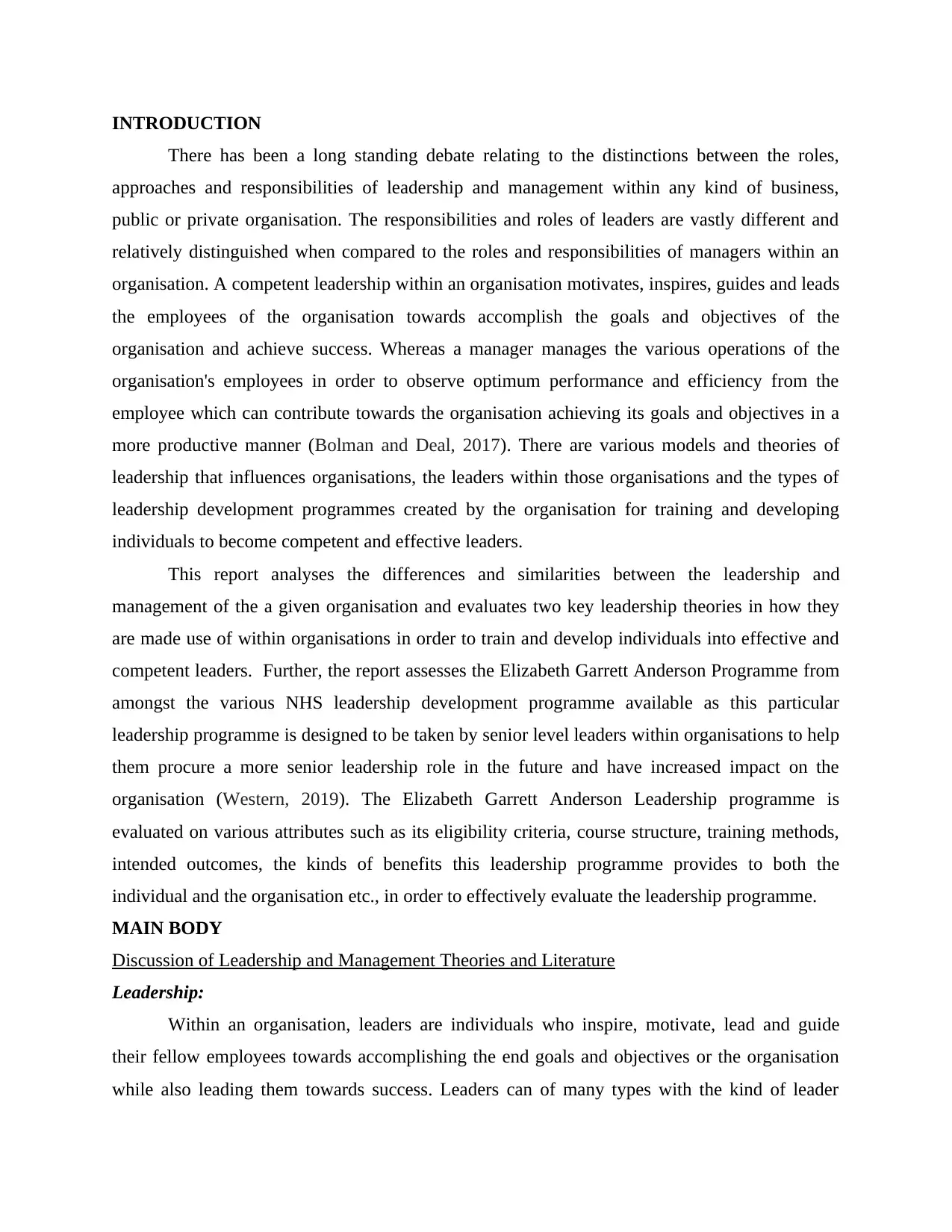
INTRODUCTION
There has been a long standing debate relating to the distinctions between the roles,
approaches and responsibilities of leadership and management within any kind of business,
public or private organisation. The responsibilities and roles of leaders are vastly different and
relatively distinguished when compared to the roles and responsibilities of managers within an
organisation. A competent leadership within an organisation motivates, inspires, guides and leads
the employees of the organisation towards accomplish the goals and objectives of the
organisation and achieve success. Whereas a manager manages the various operations of the
organisation's employees in order to observe optimum performance and efficiency from the
employee which can contribute towards the organisation achieving its goals and objectives in a
more productive manner (Bolman and Deal, 2017). There are various models and theories of
leadership that influences organisations, the leaders within those organisations and the types of
leadership development programmes created by the organisation for training and developing
individuals to become competent and effective leaders.
This report analyses the differences and similarities between the leadership and
management of the a given organisation and evaluates two key leadership theories in how they
are made use of within organisations in order to train and develop individuals into effective and
competent leaders. Further, the report assesses the Elizabeth Garrett Anderson Programme from
amongst the various NHS leadership development programme available as this particular
leadership programme is designed to be taken by senior level leaders within organisations to help
them procure a more senior leadership role in the future and have increased impact on the
organisation (Western, 2019). The Elizabeth Garrett Anderson Leadership programme is
evaluated on various attributes such as its eligibility criteria, course structure, training methods,
intended outcomes, the kinds of benefits this leadership programme provides to both the
individual and the organisation etc., in order to effectively evaluate the leadership programme.
MAIN BODY
Discussion of Leadership and Management Theories and Literature
Leadership:
Within an organisation, leaders are individuals who inspire, motivate, lead and guide
their fellow employees towards accomplishing the end goals and objectives or the organisation
while also leading them towards success. Leaders can of many types with the kind of leader
There has been a long standing debate relating to the distinctions between the roles,
approaches and responsibilities of leadership and management within any kind of business,
public or private organisation. The responsibilities and roles of leaders are vastly different and
relatively distinguished when compared to the roles and responsibilities of managers within an
organisation. A competent leadership within an organisation motivates, inspires, guides and leads
the employees of the organisation towards accomplish the goals and objectives of the
organisation and achieve success. Whereas a manager manages the various operations of the
organisation's employees in order to observe optimum performance and efficiency from the
employee which can contribute towards the organisation achieving its goals and objectives in a
more productive manner (Bolman and Deal, 2017). There are various models and theories of
leadership that influences organisations, the leaders within those organisations and the types of
leadership development programmes created by the organisation for training and developing
individuals to become competent and effective leaders.
This report analyses the differences and similarities between the leadership and
management of the a given organisation and evaluates two key leadership theories in how they
are made use of within organisations in order to train and develop individuals into effective and
competent leaders. Further, the report assesses the Elizabeth Garrett Anderson Programme from
amongst the various NHS leadership development programme available as this particular
leadership programme is designed to be taken by senior level leaders within organisations to help
them procure a more senior leadership role in the future and have increased impact on the
organisation (Western, 2019). The Elizabeth Garrett Anderson Leadership programme is
evaluated on various attributes such as its eligibility criteria, course structure, training methods,
intended outcomes, the kinds of benefits this leadership programme provides to both the
individual and the organisation etc., in order to effectively evaluate the leadership programme.
MAIN BODY
Discussion of Leadership and Management Theories and Literature
Leadership:
Within an organisation, leaders are individuals who inspire, motivate, lead and guide
their fellow employees towards accomplishing the end goals and objectives or the organisation
while also leading them towards success. Leaders can of many types with the kind of leader
⊘ This is a preview!⊘
Do you want full access?
Subscribe today to unlock all pages.

Trusted by 1+ million students worldwide
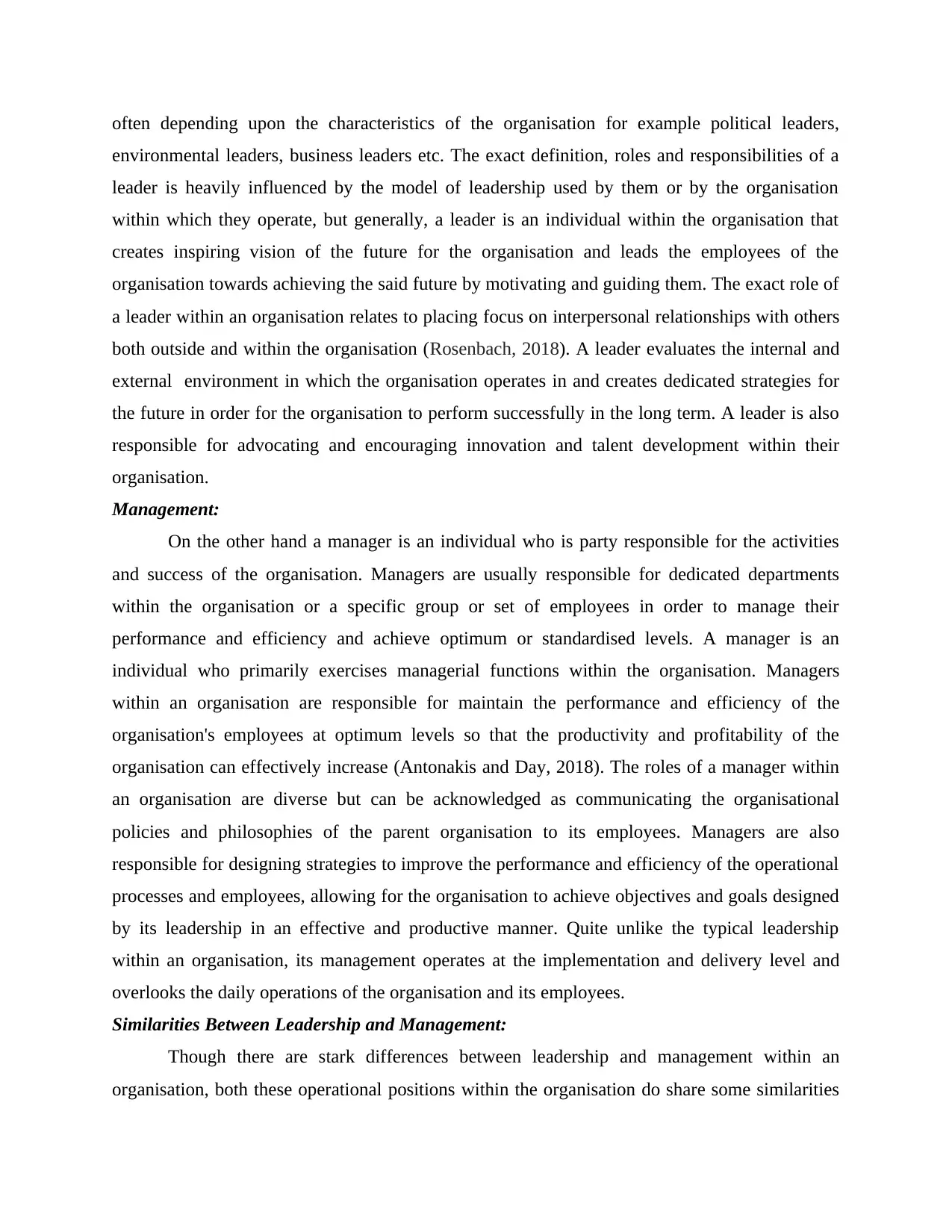
often depending upon the characteristics of the organisation for example political leaders,
environmental leaders, business leaders etc. The exact definition, roles and responsibilities of a
leader is heavily influenced by the model of leadership used by them or by the organisation
within which they operate, but generally, a leader is an individual within the organisation that
creates inspiring vision of the future for the organisation and leads the employees of the
organisation towards achieving the said future by motivating and guiding them. The exact role of
a leader within an organisation relates to placing focus on interpersonal relationships with others
both outside and within the organisation (Rosenbach, 2018). A leader evaluates the internal and
external environment in which the organisation operates in and creates dedicated strategies for
the future in order for the organisation to perform successfully in the long term. A leader is also
responsible for advocating and encouraging innovation and talent development within their
organisation.
Management:
On the other hand a manager is an individual who is party responsible for the activities
and success of the organisation. Managers are usually responsible for dedicated departments
within the organisation or a specific group or set of employees in order to manage their
performance and efficiency and achieve optimum or standardised levels. A manager is an
individual who primarily exercises managerial functions within the organisation. Managers
within an organisation are responsible for maintain the performance and efficiency of the
organisation's employees at optimum levels so that the productivity and profitability of the
organisation can effectively increase (Antonakis and Day, 2018). The roles of a manager within
an organisation are diverse but can be acknowledged as communicating the organisational
policies and philosophies of the parent organisation to its employees. Managers are also
responsible for designing strategies to improve the performance and efficiency of the operational
processes and employees, allowing for the organisation to achieve objectives and goals designed
by its leadership in an effective and productive manner. Quite unlike the typical leadership
within an organisation, its management operates at the implementation and delivery level and
overlooks the daily operations of the organisation and its employees.
Similarities Between Leadership and Management:
Though there are stark differences between leadership and management within an
organisation, both these operational positions within the organisation do share some similarities
environmental leaders, business leaders etc. The exact definition, roles and responsibilities of a
leader is heavily influenced by the model of leadership used by them or by the organisation
within which they operate, but generally, a leader is an individual within the organisation that
creates inspiring vision of the future for the organisation and leads the employees of the
organisation towards achieving the said future by motivating and guiding them. The exact role of
a leader within an organisation relates to placing focus on interpersonal relationships with others
both outside and within the organisation (Rosenbach, 2018). A leader evaluates the internal and
external environment in which the organisation operates in and creates dedicated strategies for
the future in order for the organisation to perform successfully in the long term. A leader is also
responsible for advocating and encouraging innovation and talent development within their
organisation.
Management:
On the other hand a manager is an individual who is party responsible for the activities
and success of the organisation. Managers are usually responsible for dedicated departments
within the organisation or a specific group or set of employees in order to manage their
performance and efficiency and achieve optimum or standardised levels. A manager is an
individual who primarily exercises managerial functions within the organisation. Managers
within an organisation are responsible for maintain the performance and efficiency of the
organisation's employees at optimum levels so that the productivity and profitability of the
organisation can effectively increase (Antonakis and Day, 2018). The roles of a manager within
an organisation are diverse but can be acknowledged as communicating the organisational
policies and philosophies of the parent organisation to its employees. Managers are also
responsible for designing strategies to improve the performance and efficiency of the operational
processes and employees, allowing for the organisation to achieve objectives and goals designed
by its leadership in an effective and productive manner. Quite unlike the typical leadership
within an organisation, its management operates at the implementation and delivery level and
overlooks the daily operations of the organisation and its employees.
Similarities Between Leadership and Management:
Though there are stark differences between leadership and management within an
organisation, both these operational positions within the organisation do share some similarities
Paraphrase This Document
Need a fresh take? Get an instant paraphrase of this document with our AI Paraphraser
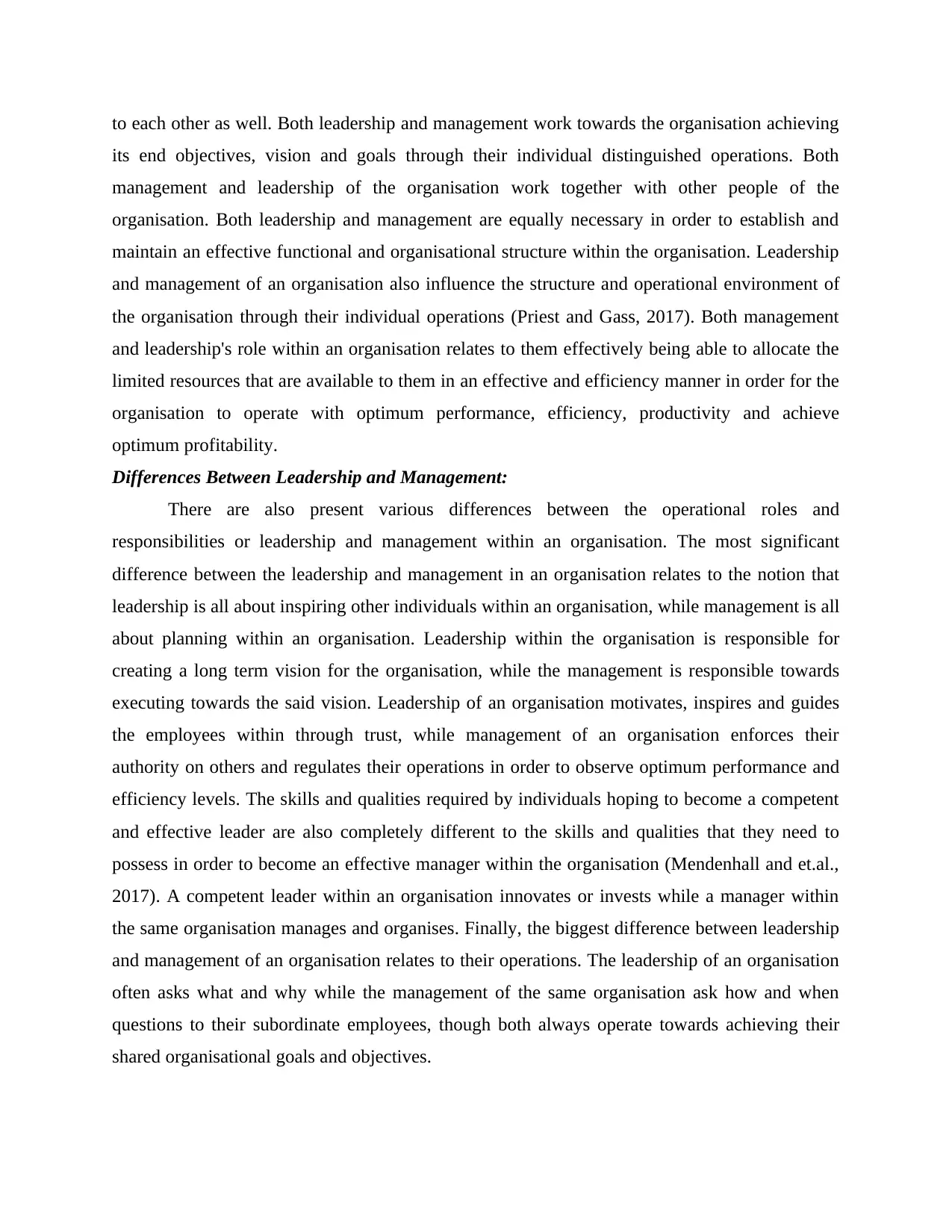
to each other as well. Both leadership and management work towards the organisation achieving
its end objectives, vision and goals through their individual distinguished operations. Both
management and leadership of the organisation work together with other people of the
organisation. Both leadership and management are equally necessary in order to establish and
maintain an effective functional and organisational structure within the organisation. Leadership
and management of an organisation also influence the structure and operational environment of
the organisation through their individual operations (Priest and Gass, 2017). Both management
and leadership's role within an organisation relates to them effectively being able to allocate the
limited resources that are available to them in an effective and efficiency manner in order for the
organisation to operate with optimum performance, efficiency, productivity and achieve
optimum profitability.
Differences Between Leadership and Management:
There are also present various differences between the operational roles and
responsibilities or leadership and management within an organisation. The most significant
difference between the leadership and management in an organisation relates to the notion that
leadership is all about inspiring other individuals within an organisation, while management is all
about planning within an organisation. Leadership within the organisation is responsible for
creating a long term vision for the organisation, while the management is responsible towards
executing towards the said vision. Leadership of an organisation motivates, inspires and guides
the employees within through trust, while management of an organisation enforces their
authority on others and regulates their operations in order to observe optimum performance and
efficiency levels. The skills and qualities required by individuals hoping to become a competent
and effective leader are also completely different to the skills and qualities that they need to
possess in order to become an effective manager within the organisation (Mendenhall and et.al.,
2017). A competent leader within an organisation innovates or invests while a manager within
the same organisation manages and organises. Finally, the biggest difference between leadership
and management of an organisation relates to their operations. The leadership of an organisation
often asks what and why while the management of the same organisation ask how and when
questions to their subordinate employees, though both always operate towards achieving their
shared organisational goals and objectives.
its end objectives, vision and goals through their individual distinguished operations. Both
management and leadership of the organisation work together with other people of the
organisation. Both leadership and management are equally necessary in order to establish and
maintain an effective functional and organisational structure within the organisation. Leadership
and management of an organisation also influence the structure and operational environment of
the organisation through their individual operations (Priest and Gass, 2017). Both management
and leadership's role within an organisation relates to them effectively being able to allocate the
limited resources that are available to them in an effective and efficiency manner in order for the
organisation to operate with optimum performance, efficiency, productivity and achieve
optimum profitability.
Differences Between Leadership and Management:
There are also present various differences between the operational roles and
responsibilities or leadership and management within an organisation. The most significant
difference between the leadership and management in an organisation relates to the notion that
leadership is all about inspiring other individuals within an organisation, while management is all
about planning within an organisation. Leadership within the organisation is responsible for
creating a long term vision for the organisation, while the management is responsible towards
executing towards the said vision. Leadership of an organisation motivates, inspires and guides
the employees within through trust, while management of an organisation enforces their
authority on others and regulates their operations in order to observe optimum performance and
efficiency levels. The skills and qualities required by individuals hoping to become a competent
and effective leader are also completely different to the skills and qualities that they need to
possess in order to become an effective manager within the organisation (Mendenhall and et.al.,
2017). A competent leader within an organisation innovates or invests while a manager within
the same organisation manages and organises. Finally, the biggest difference between leadership
and management of an organisation relates to their operations. The leadership of an organisation
often asks what and why while the management of the same organisation ask how and when
questions to their subordinate employees, though both always operate towards achieving their
shared organisational goals and objectives.
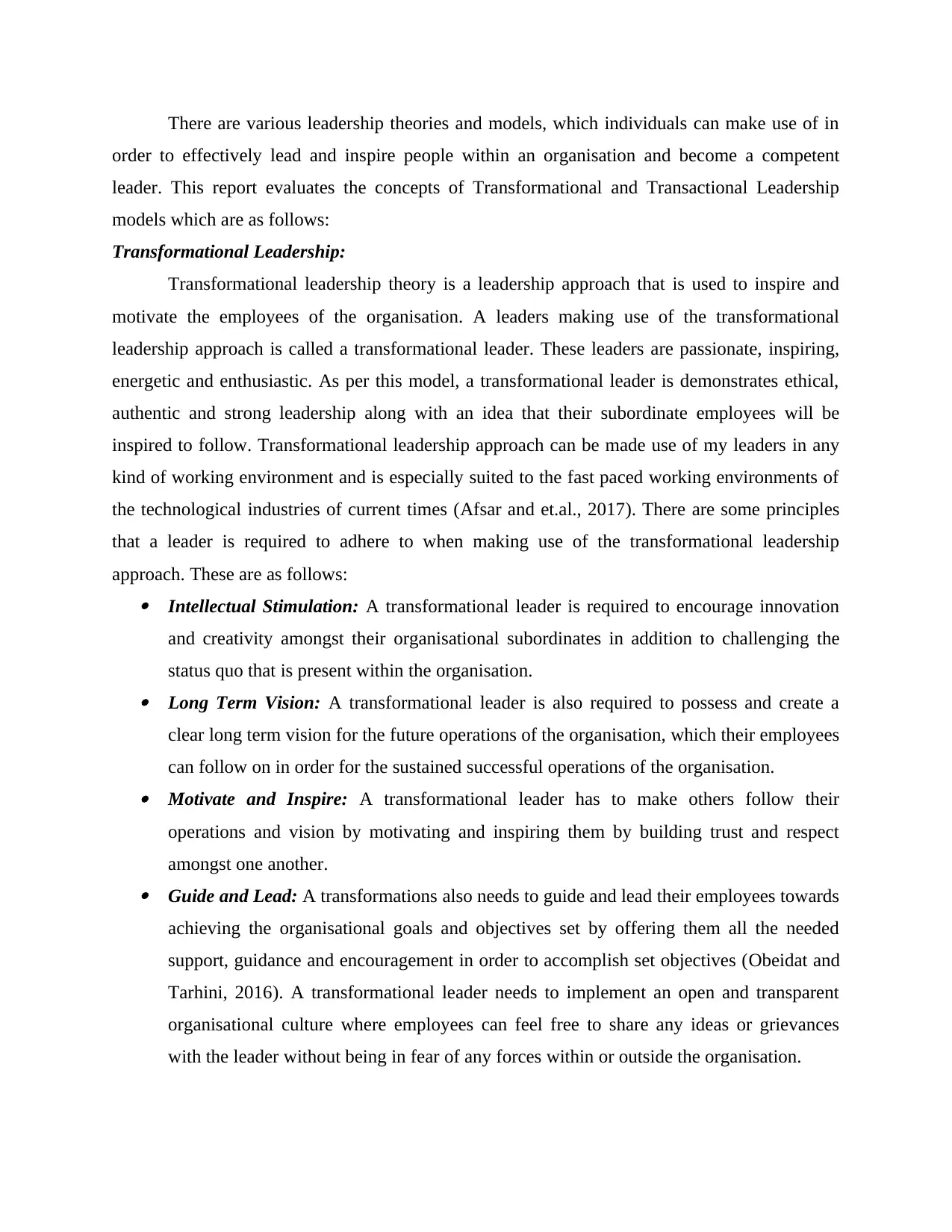
There are various leadership theories and models, which individuals can make use of in
order to effectively lead and inspire people within an organisation and become a competent
leader. This report evaluates the concepts of Transformational and Transactional Leadership
models which are as follows:
Transformational Leadership:
Transformational leadership theory is a leadership approach that is used to inspire and
motivate the employees of the organisation. A leaders making use of the transformational
leadership approach is called a transformational leader. These leaders are passionate, inspiring,
energetic and enthusiastic. As per this model, a transformational leader is demonstrates ethical,
authentic and strong leadership along with an idea that their subordinate employees will be
inspired to follow. Transformational leadership approach can be made use of my leaders in any
kind of working environment and is especially suited to the fast paced working environments of
the technological industries of current times (Afsar and et.al., 2017). There are some principles
that a leader is required to adhere to when making use of the transformational leadership
approach. These are as follows: Intellectual Stimulation: A transformational leader is required to encourage innovation
and creativity amongst their organisational subordinates in addition to challenging the
status quo that is present within the organisation. Long Term Vision: A transformational leader is also required to possess and create a
clear long term vision for the future operations of the organisation, which their employees
can follow on in order for the sustained successful operations of the organisation. Motivate and Inspire: A transformational leader has to make others follow their
operations and vision by motivating and inspiring them by building trust and respect
amongst one another. Guide and Lead: A transformations also needs to guide and lead their employees towards
achieving the organisational goals and objectives set by offering them all the needed
support, guidance and encouragement in order to accomplish set objectives (Obeidat and
Tarhini, 2016). A transformational leader needs to implement an open and transparent
organisational culture where employees can feel free to share any ideas or grievances
with the leader without being in fear of any forces within or outside the organisation.
order to effectively lead and inspire people within an organisation and become a competent
leader. This report evaluates the concepts of Transformational and Transactional Leadership
models which are as follows:
Transformational Leadership:
Transformational leadership theory is a leadership approach that is used to inspire and
motivate the employees of the organisation. A leaders making use of the transformational
leadership approach is called a transformational leader. These leaders are passionate, inspiring,
energetic and enthusiastic. As per this model, a transformational leader is demonstrates ethical,
authentic and strong leadership along with an idea that their subordinate employees will be
inspired to follow. Transformational leadership approach can be made use of my leaders in any
kind of working environment and is especially suited to the fast paced working environments of
the technological industries of current times (Afsar and et.al., 2017). There are some principles
that a leader is required to adhere to when making use of the transformational leadership
approach. These are as follows: Intellectual Stimulation: A transformational leader is required to encourage innovation
and creativity amongst their organisational subordinates in addition to challenging the
status quo that is present within the organisation. Long Term Vision: A transformational leader is also required to possess and create a
clear long term vision for the future operations of the organisation, which their employees
can follow on in order for the sustained successful operations of the organisation. Motivate and Inspire: A transformational leader has to make others follow their
operations and vision by motivating and inspiring them by building trust and respect
amongst one another. Guide and Lead: A transformations also needs to guide and lead their employees towards
achieving the organisational goals and objectives set by offering them all the needed
support, guidance and encouragement in order to accomplish set objectives (Obeidat and
Tarhini, 2016). A transformational leader needs to implement an open and transparent
organisational culture where employees can feel free to share any ideas or grievances
with the leader without being in fear of any forces within or outside the organisation.
⊘ This is a preview!⊘
Do you want full access?
Subscribe today to unlock all pages.

Trusted by 1+ million students worldwide
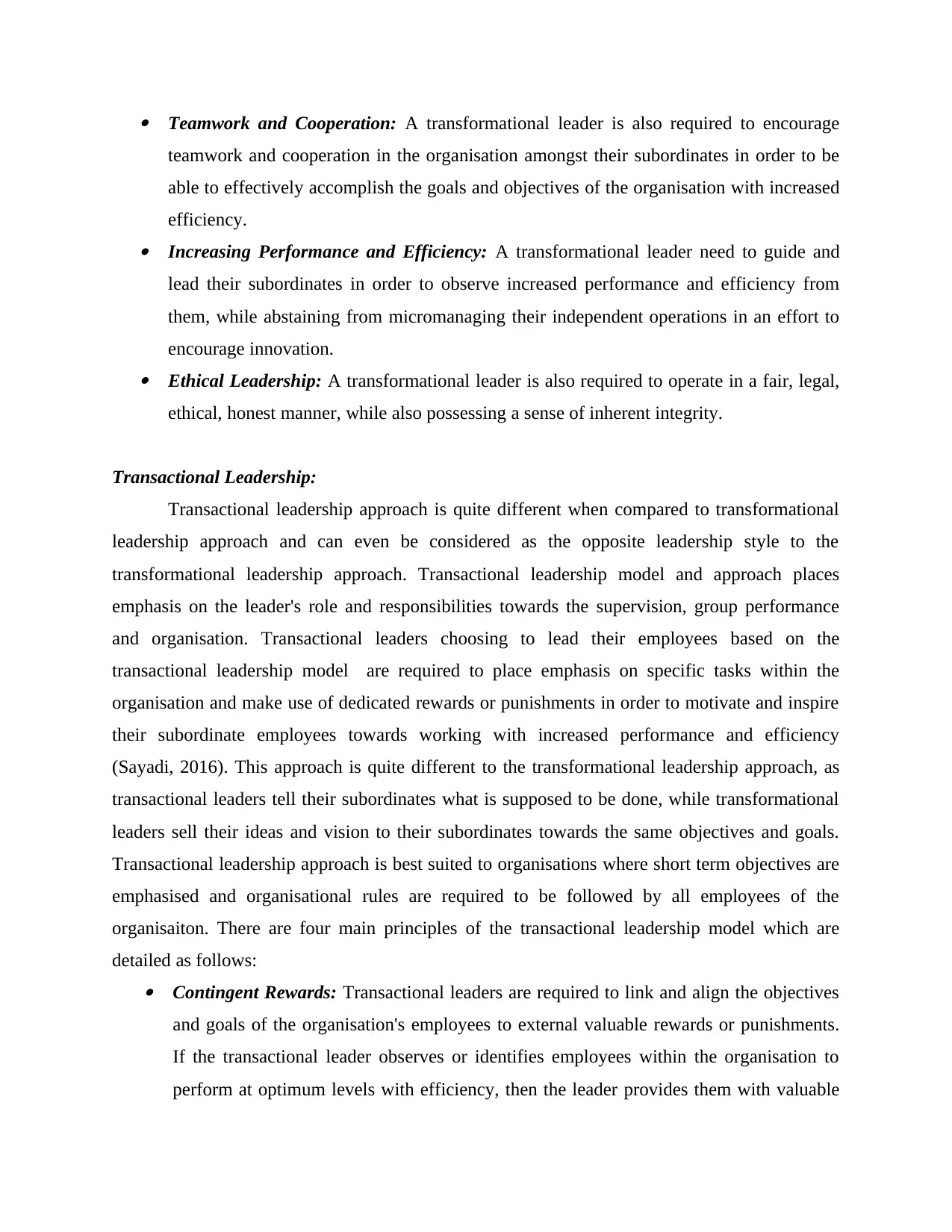
Teamwork and Cooperation: A transformational leader is also required to encourage
teamwork and cooperation in the organisation amongst their subordinates in order to be
able to effectively accomplish the goals and objectives of the organisation with increased
efficiency. Increasing Performance and Efficiency: A transformational leader need to guide and
lead their subordinates in order to observe increased performance and efficiency from
them, while abstaining from micromanaging their independent operations in an effort to
encourage innovation. Ethical Leadership: A transformational leader is also required to operate in a fair, legal,
ethical, honest manner, while also possessing a sense of inherent integrity.
Transactional Leadership:
Transactional leadership approach is quite different when compared to transformational
leadership approach and can even be considered as the opposite leadership style to the
transformational leadership approach. Transactional leadership model and approach places
emphasis on the leader's role and responsibilities towards the supervision, group performance
and organisation. Transactional leaders choosing to lead their employees based on the
transactional leadership model are required to place emphasis on specific tasks within the
organisation and make use of dedicated rewards or punishments in order to motivate and inspire
their subordinate employees towards working with increased performance and efficiency
(Sayadi, 2016). This approach is quite different to the transformational leadership approach, as
transactional leaders tell their subordinates what is supposed to be done, while transformational
leaders sell their ideas and vision to their subordinates towards the same objectives and goals.
Transactional leadership approach is best suited to organisations where short term objectives are
emphasised and organisational rules are required to be followed by all employees of the
organisaiton. There are four main principles of the transactional leadership model which are
detailed as follows: Contingent Rewards: Transactional leaders are required to link and align the objectives
and goals of the organisation's employees to external valuable rewards or punishments.
If the transactional leader observes or identifies employees within the organisation to
perform at optimum levels with efficiency, then the leader provides them with valuable
teamwork and cooperation in the organisation amongst their subordinates in order to be
able to effectively accomplish the goals and objectives of the organisation with increased
efficiency. Increasing Performance and Efficiency: A transformational leader need to guide and
lead their subordinates in order to observe increased performance and efficiency from
them, while abstaining from micromanaging their independent operations in an effort to
encourage innovation. Ethical Leadership: A transformational leader is also required to operate in a fair, legal,
ethical, honest manner, while also possessing a sense of inherent integrity.
Transactional Leadership:
Transactional leadership approach is quite different when compared to transformational
leadership approach and can even be considered as the opposite leadership style to the
transformational leadership approach. Transactional leadership model and approach places
emphasis on the leader's role and responsibilities towards the supervision, group performance
and organisation. Transactional leaders choosing to lead their employees based on the
transactional leadership model are required to place emphasis on specific tasks within the
organisation and make use of dedicated rewards or punishments in order to motivate and inspire
their subordinate employees towards working with increased performance and efficiency
(Sayadi, 2016). This approach is quite different to the transformational leadership approach, as
transactional leaders tell their subordinates what is supposed to be done, while transformational
leaders sell their ideas and vision to their subordinates towards the same objectives and goals.
Transactional leadership approach is best suited to organisations where short term objectives are
emphasised and organisational rules are required to be followed by all employees of the
organisaiton. There are four main principles of the transactional leadership model which are
detailed as follows: Contingent Rewards: Transactional leaders are required to link and align the objectives
and goals of the organisation's employees to external valuable rewards or punishments.
If the transactional leader observes or identifies employees within the organisation to
perform at optimum levels with efficiency, then the leader provides them with valuable
Paraphrase This Document
Need a fresh take? Get an instant paraphrase of this document with our AI Paraphraser
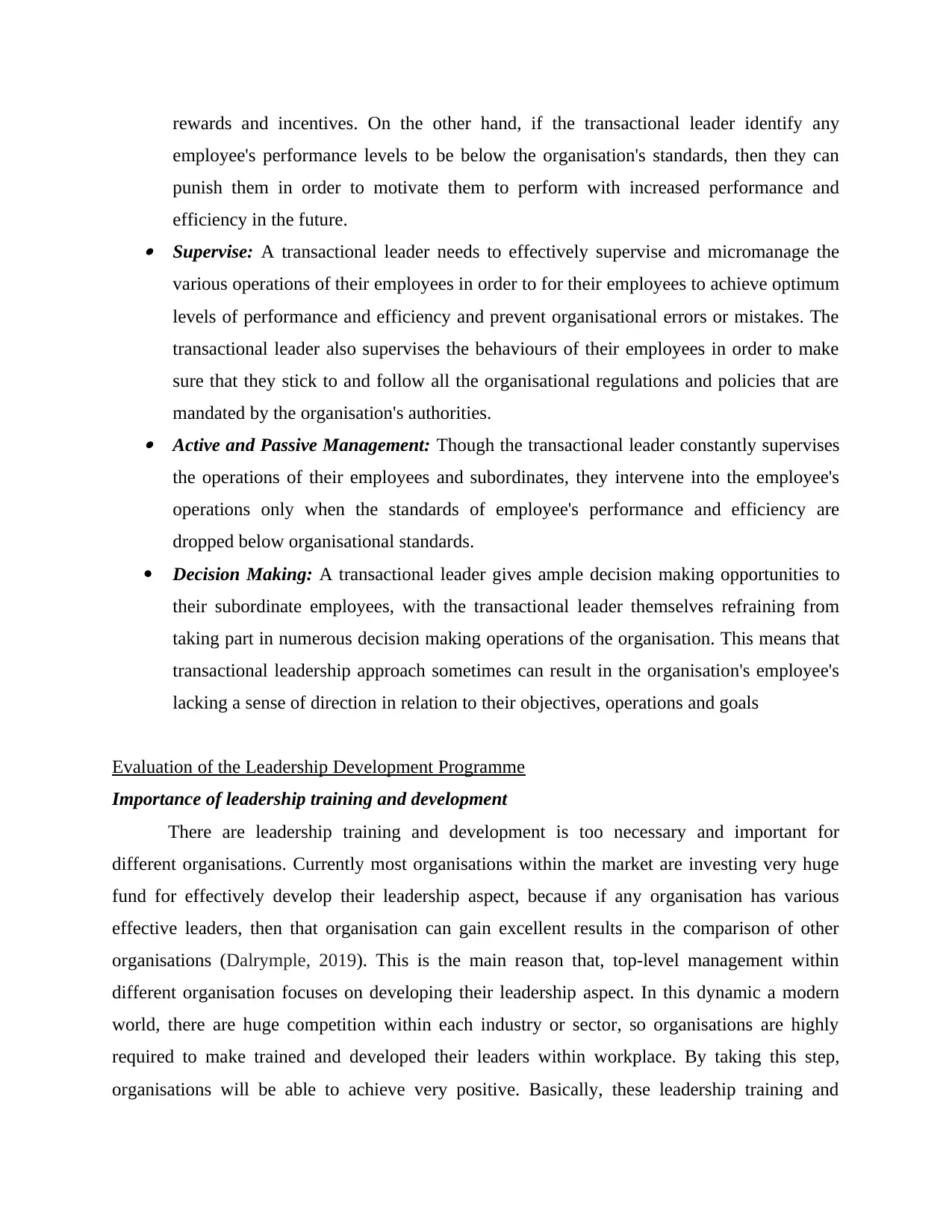
rewards and incentives. On the other hand, if the transactional leader identify any
employee's performance levels to be below the organisation's standards, then they can
punish them in order to motivate them to perform with increased performance and
efficiency in the future. Supervise: A transactional leader needs to effectively supervise and micromanage the
various operations of their employees in order to for their employees to achieve optimum
levels of performance and efficiency and prevent organisational errors or mistakes. The
transactional leader also supervises the behaviours of their employees in order to make
sure that they stick to and follow all the organisational regulations and policies that are
mandated by the organisation's authorities. Active and Passive Management: Though the transactional leader constantly supervises
the operations of their employees and subordinates, they intervene into the employee's
operations only when the standards of employee's performance and efficiency are
dropped below organisational standards.
Decision Making: A transactional leader gives ample decision making opportunities to
their subordinate employees, with the transactional leader themselves refraining from
taking part in numerous decision making operations of the organisation. This means that
transactional leadership approach sometimes can result in the organisation's employee's
lacking a sense of direction in relation to their objectives, operations and goals
Evaluation of the Leadership Development Programme
Importance of leadership training and development
There are leadership training and development is too necessary and important for
different organisations. Currently most organisations within the market are investing very huge
fund for effectively develop their leadership aspect, because if any organisation has various
effective leaders, then that organisation can gain excellent results in the comparison of other
organisations (Dalrymple, 2019). This is the main reason that, top-level management within
different organisation focuses on developing their leadership aspect. In this dynamic a modern
world, there are huge competition within each industry or sector, so organisations are highly
required to make trained and developed their leaders within workplace. By taking this step,
organisations will be able to achieve very positive. Basically, these leadership training and
employee's performance levels to be below the organisation's standards, then they can
punish them in order to motivate them to perform with increased performance and
efficiency in the future. Supervise: A transactional leader needs to effectively supervise and micromanage the
various operations of their employees in order to for their employees to achieve optimum
levels of performance and efficiency and prevent organisational errors or mistakes. The
transactional leader also supervises the behaviours of their employees in order to make
sure that they stick to and follow all the organisational regulations and policies that are
mandated by the organisation's authorities. Active and Passive Management: Though the transactional leader constantly supervises
the operations of their employees and subordinates, they intervene into the employee's
operations only when the standards of employee's performance and efficiency are
dropped below organisational standards.
Decision Making: A transactional leader gives ample decision making opportunities to
their subordinate employees, with the transactional leader themselves refraining from
taking part in numerous decision making operations of the organisation. This means that
transactional leadership approach sometimes can result in the organisation's employee's
lacking a sense of direction in relation to their objectives, operations and goals
Evaluation of the Leadership Development Programme
Importance of leadership training and development
There are leadership training and development is too necessary and important for
different organisations. Currently most organisations within the market are investing very huge
fund for effectively develop their leadership aspect, because if any organisation has various
effective leaders, then that organisation can gain excellent results in the comparison of other
organisations (Dalrymple, 2019). This is the main reason that, top-level management within
different organisation focuses on developing their leadership aspect. In this dynamic a modern
world, there are huge competition within each industry or sector, so organisations are highly
required to make trained and developed their leaders within workplace. By taking this step,
organisations will be able to achieve very positive. Basically, these leadership training and
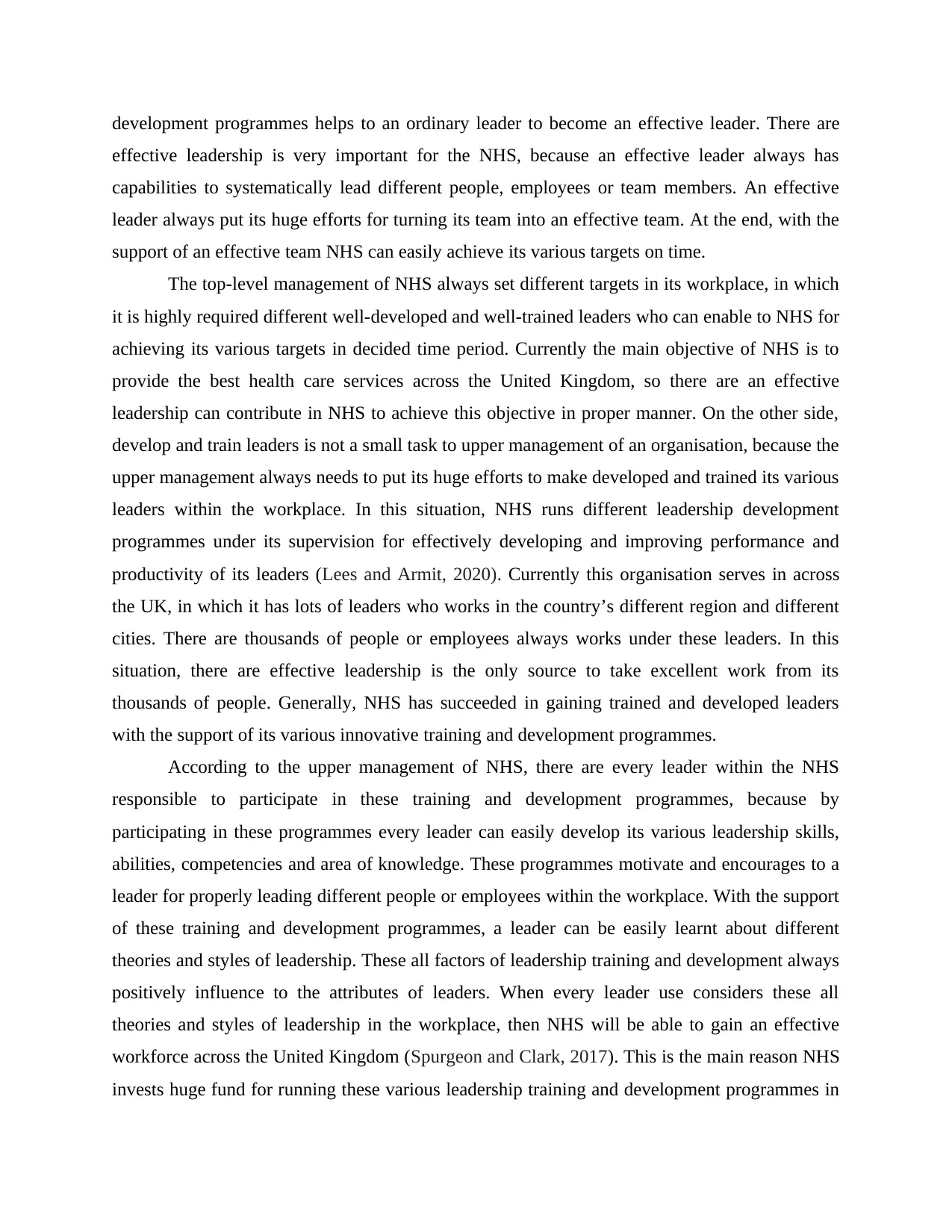
development programmes helps to an ordinary leader to become an effective leader. There are
effective leadership is very important for the NHS, because an effective leader always has
capabilities to systematically lead different people, employees or team members. An effective
leader always put its huge efforts for turning its team into an effective team. At the end, with the
support of an effective team NHS can easily achieve its various targets on time.
The top-level management of NHS always set different targets in its workplace, in which
it is highly required different well-developed and well-trained leaders who can enable to NHS for
achieving its various targets in decided time period. Currently the main objective of NHS is to
provide the best health care services across the United Kingdom, so there are an effective
leadership can contribute in NHS to achieve this objective in proper manner. On the other side,
develop and train leaders is not a small task to upper management of an organisation, because the
upper management always needs to put its huge efforts to make developed and trained its various
leaders within the workplace. In this situation, NHS runs different leadership development
programmes under its supervision for effectively developing and improving performance and
productivity of its leaders (Lees and Armit, 2020). Currently this organisation serves in across
the UK, in which it has lots of leaders who works in the country’s different region and different
cities. There are thousands of people or employees always works under these leaders. In this
situation, there are effective leadership is the only source to take excellent work from its
thousands of people. Generally, NHS has succeeded in gaining trained and developed leaders
with the support of its various innovative training and development programmes.
According to the upper management of NHS, there are every leader within the NHS
responsible to participate in these training and development programmes, because by
participating in these programmes every leader can easily develop its various leadership skills,
abilities, competencies and area of knowledge. These programmes motivate and encourages to a
leader for properly leading different people or employees within the workplace. With the support
of these training and development programmes, a leader can be easily learnt about different
theories and styles of leadership. These all factors of leadership training and development always
positively influence to the attributes of leaders. When every leader use considers these all
theories and styles of leadership in the workplace, then NHS will be able to gain an effective
workforce across the United Kingdom (Spurgeon and Clark, 2017). This is the main reason NHS
invests huge fund for running these various leadership training and development programmes in
effective leadership is very important for the NHS, because an effective leader always has
capabilities to systematically lead different people, employees or team members. An effective
leader always put its huge efforts for turning its team into an effective team. At the end, with the
support of an effective team NHS can easily achieve its various targets on time.
The top-level management of NHS always set different targets in its workplace, in which
it is highly required different well-developed and well-trained leaders who can enable to NHS for
achieving its various targets in decided time period. Currently the main objective of NHS is to
provide the best health care services across the United Kingdom, so there are an effective
leadership can contribute in NHS to achieve this objective in proper manner. On the other side,
develop and train leaders is not a small task to upper management of an organisation, because the
upper management always needs to put its huge efforts to make developed and trained its various
leaders within the workplace. In this situation, NHS runs different leadership development
programmes under its supervision for effectively developing and improving performance and
productivity of its leaders (Lees and Armit, 2020). Currently this organisation serves in across
the UK, in which it has lots of leaders who works in the country’s different region and different
cities. There are thousands of people or employees always works under these leaders. In this
situation, there are effective leadership is the only source to take excellent work from its
thousands of people. Generally, NHS has succeeded in gaining trained and developed leaders
with the support of its various innovative training and development programmes.
According to the upper management of NHS, there are every leader within the NHS
responsible to participate in these training and development programmes, because by
participating in these programmes every leader can easily develop its various leadership skills,
abilities, competencies and area of knowledge. These programmes motivate and encourages to a
leader for properly leading different people or employees within the workplace. With the support
of these training and development programmes, a leader can be easily learnt about different
theories and styles of leadership. These all factors of leadership training and development always
positively influence to the attributes of leaders. When every leader use considers these all
theories and styles of leadership in the workplace, then NHS will be able to gain an effective
workforce across the United Kingdom (Spurgeon and Clark, 2017). This is the main reason NHS
invests huge fund for running these various leadership training and development programmes in
⊘ This is a preview!⊘
Do you want full access?
Subscribe today to unlock all pages.

Trusted by 1+ million students worldwide
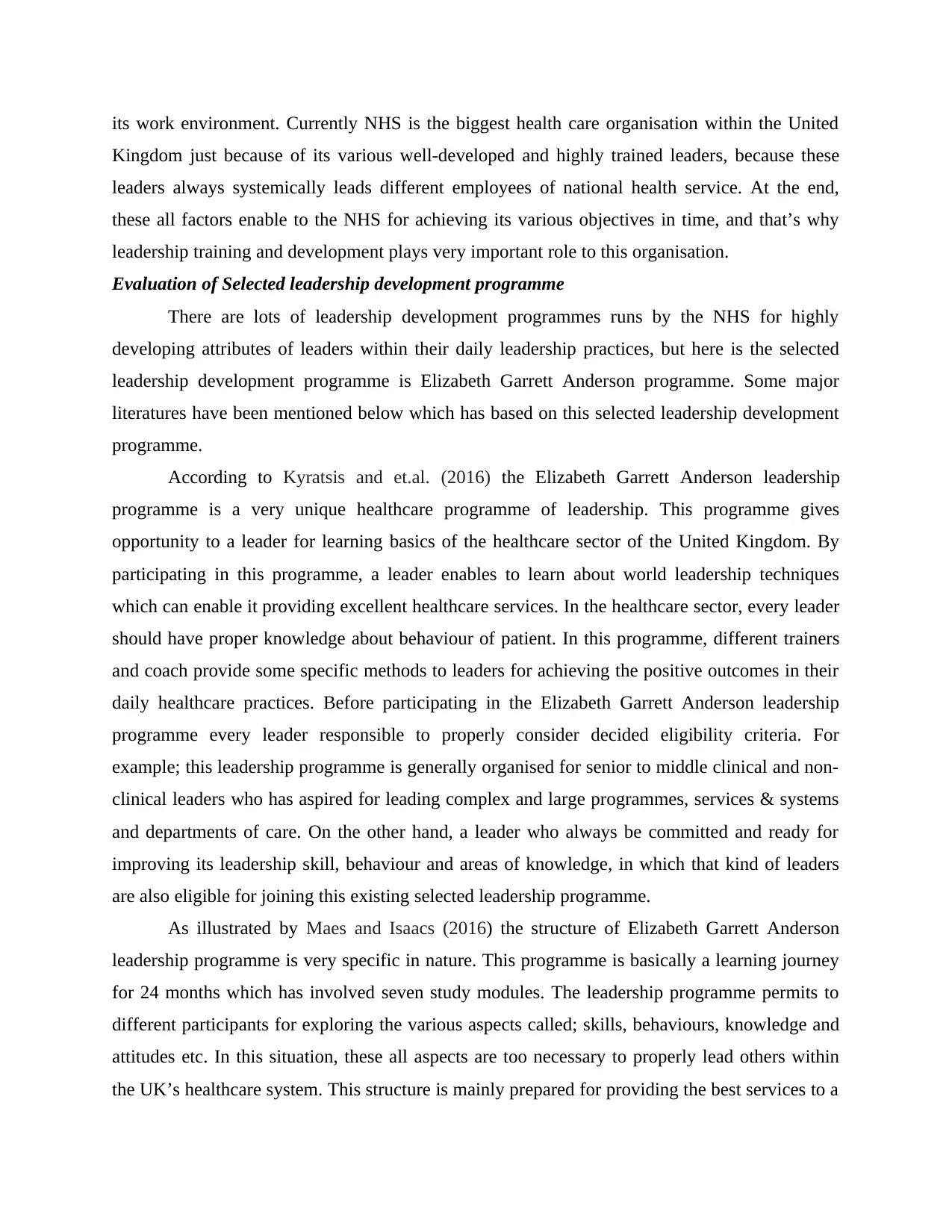
its work environment. Currently NHS is the biggest health care organisation within the United
Kingdom just because of its various well-developed and highly trained leaders, because these
leaders always systemically leads different employees of national health service. At the end,
these all factors enable to the NHS for achieving its various objectives in time, and that’s why
leadership training and development plays very important role to this organisation.
Evaluation of Selected leadership development programme
There are lots of leadership development programmes runs by the NHS for highly
developing attributes of leaders within their daily leadership practices, but here is the selected
leadership development programme is Elizabeth Garrett Anderson programme. Some major
literatures have been mentioned below which has based on this selected leadership development
programme.
According to Kyratsis and et.al. (2016) the Elizabeth Garrett Anderson leadership
programme is a very unique healthcare programme of leadership. This programme gives
opportunity to a leader for learning basics of the healthcare sector of the United Kingdom. By
participating in this programme, a leader enables to learn about world leadership techniques
which can enable it providing excellent healthcare services. In the healthcare sector, every leader
should have proper knowledge about behaviour of patient. In this programme, different trainers
and coach provide some specific methods to leaders for achieving the positive outcomes in their
daily healthcare practices. Before participating in the Elizabeth Garrett Anderson leadership
programme every leader responsible to properly consider decided eligibility criteria. For
example; this leadership programme is generally organised for senior to middle clinical and non-
clinical leaders who has aspired for leading complex and large programmes, services & systems
and departments of care. On the other hand, a leader who always be committed and ready for
improving its leadership skill, behaviour and areas of knowledge, in which that kind of leaders
are also eligible for joining this existing selected leadership programme.
As illustrated by Maes and Isaacs (2016) the structure of Elizabeth Garrett Anderson
leadership programme is very specific in nature. This programme is basically a learning journey
for 24 months which has involved seven study modules. The leadership programme permits to
different participants for exploring the various aspects called; skills, behaviours, knowledge and
attitudes etc. In this situation, these all aspects are too necessary to properly lead others within
the UK’s healthcare system. This structure is mainly prepared for providing the best services to a
Kingdom just because of its various well-developed and highly trained leaders, because these
leaders always systemically leads different employees of national health service. At the end,
these all factors enable to the NHS for achieving its various objectives in time, and that’s why
leadership training and development plays very important role to this organisation.
Evaluation of Selected leadership development programme
There are lots of leadership development programmes runs by the NHS for highly
developing attributes of leaders within their daily leadership practices, but here is the selected
leadership development programme is Elizabeth Garrett Anderson programme. Some major
literatures have been mentioned below which has based on this selected leadership development
programme.
According to Kyratsis and et.al. (2016) the Elizabeth Garrett Anderson leadership
programme is a very unique healthcare programme of leadership. This programme gives
opportunity to a leader for learning basics of the healthcare sector of the United Kingdom. By
participating in this programme, a leader enables to learn about world leadership techniques
which can enable it providing excellent healthcare services. In the healthcare sector, every leader
should have proper knowledge about behaviour of patient. In this programme, different trainers
and coach provide some specific methods to leaders for achieving the positive outcomes in their
daily healthcare practices. Before participating in the Elizabeth Garrett Anderson leadership
programme every leader responsible to properly consider decided eligibility criteria. For
example; this leadership programme is generally organised for senior to middle clinical and non-
clinical leaders who has aspired for leading complex and large programmes, services & systems
and departments of care. On the other hand, a leader who always be committed and ready for
improving its leadership skill, behaviour and areas of knowledge, in which that kind of leaders
are also eligible for joining this existing selected leadership programme.
As illustrated by Maes and Isaacs (2016) the structure of Elizabeth Garrett Anderson
leadership programme is very specific in nature. This programme is basically a learning journey
for 24 months which has involved seven study modules. The leadership programme permits to
different participants for exploring the various aspects called; skills, behaviours, knowledge and
attitudes etc. In this situation, these all aspects are too necessary to properly lead others within
the UK’s healthcare system. This structure is mainly prepared for providing the best services to a
Paraphrase This Document
Need a fresh take? Get an instant paraphrase of this document with our AI Paraphraser
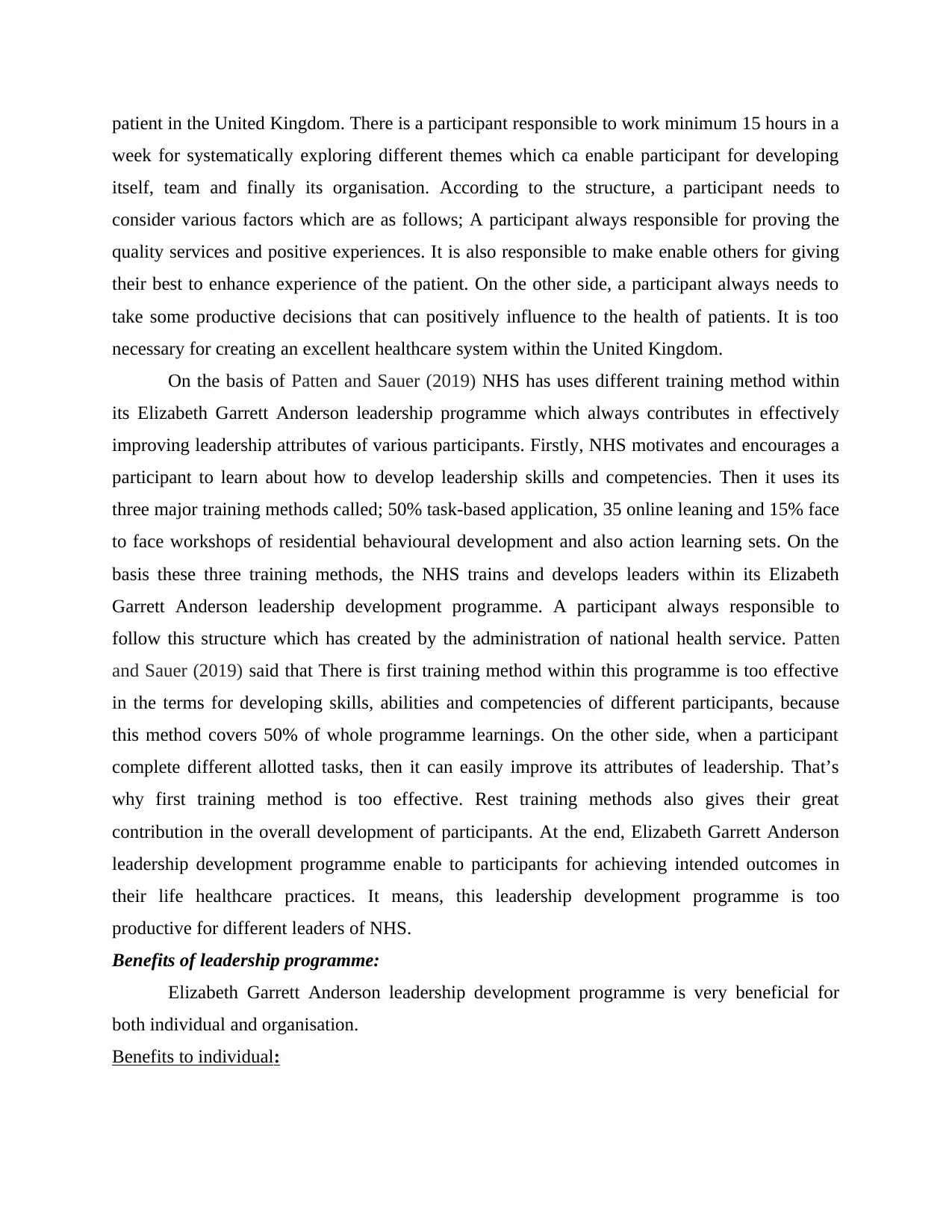
patient in the United Kingdom. There is a participant responsible to work minimum 15 hours in a
week for systematically exploring different themes which ca enable participant for developing
itself, team and finally its organisation. According to the structure, a participant needs to
consider various factors which are as follows; A participant always responsible for proving the
quality services and positive experiences. It is also responsible to make enable others for giving
their best to enhance experience of the patient. On the other side, a participant always needs to
take some productive decisions that can positively influence to the health of patients. It is too
necessary for creating an excellent healthcare system within the United Kingdom.
On the basis of Patten and Sauer (2019) NHS has uses different training method within
its Elizabeth Garrett Anderson leadership programme which always contributes in effectively
improving leadership attributes of various participants. Firstly, NHS motivates and encourages a
participant to learn about how to develop leadership skills and competencies. Then it uses its
three major training methods called; 50% task-based application, 35 online leaning and 15% face
to face workshops of residential behavioural development and also action learning sets. On the
basis these three training methods, the NHS trains and develops leaders within its Elizabeth
Garrett Anderson leadership development programme. A participant always responsible to
follow this structure which has created by the administration of national health service. Patten
and Sauer (2019) said that There is first training method within this programme is too effective
in the terms for developing skills, abilities and competencies of different participants, because
this method covers 50% of whole programme learnings. On the other side, when a participant
complete different allotted tasks, then it can easily improve its attributes of leadership. That’s
why first training method is too effective. Rest training methods also gives their great
contribution in the overall development of participants. At the end, Elizabeth Garrett Anderson
leadership development programme enable to participants for achieving intended outcomes in
their life healthcare practices. It means, this leadership development programme is too
productive for different leaders of NHS.
Benefits of leadership programme:
Elizabeth Garrett Anderson leadership development programme is very beneficial for
both individual and organisation.
Benefits to individual:
week for systematically exploring different themes which ca enable participant for developing
itself, team and finally its organisation. According to the structure, a participant needs to
consider various factors which are as follows; A participant always responsible for proving the
quality services and positive experiences. It is also responsible to make enable others for giving
their best to enhance experience of the patient. On the other side, a participant always needs to
take some productive decisions that can positively influence to the health of patients. It is too
necessary for creating an excellent healthcare system within the United Kingdom.
On the basis of Patten and Sauer (2019) NHS has uses different training method within
its Elizabeth Garrett Anderson leadership programme which always contributes in effectively
improving leadership attributes of various participants. Firstly, NHS motivates and encourages a
participant to learn about how to develop leadership skills and competencies. Then it uses its
three major training methods called; 50% task-based application, 35 online leaning and 15% face
to face workshops of residential behavioural development and also action learning sets. On the
basis these three training methods, the NHS trains and develops leaders within its Elizabeth
Garrett Anderson leadership development programme. A participant always responsible to
follow this structure which has created by the administration of national health service. Patten
and Sauer (2019) said that There is first training method within this programme is too effective
in the terms for developing skills, abilities and competencies of different participants, because
this method covers 50% of whole programme learnings. On the other side, when a participant
complete different allotted tasks, then it can easily improve its attributes of leadership. That’s
why first training method is too effective. Rest training methods also gives their great
contribution in the overall development of participants. At the end, Elizabeth Garrett Anderson
leadership development programme enable to participants for achieving intended outcomes in
their life healthcare practices. It means, this leadership development programme is too
productive for different leaders of NHS.
Benefits of leadership programme:
Elizabeth Garrett Anderson leadership development programme is very beneficial for
both individual and organisation.
Benefits to individual:
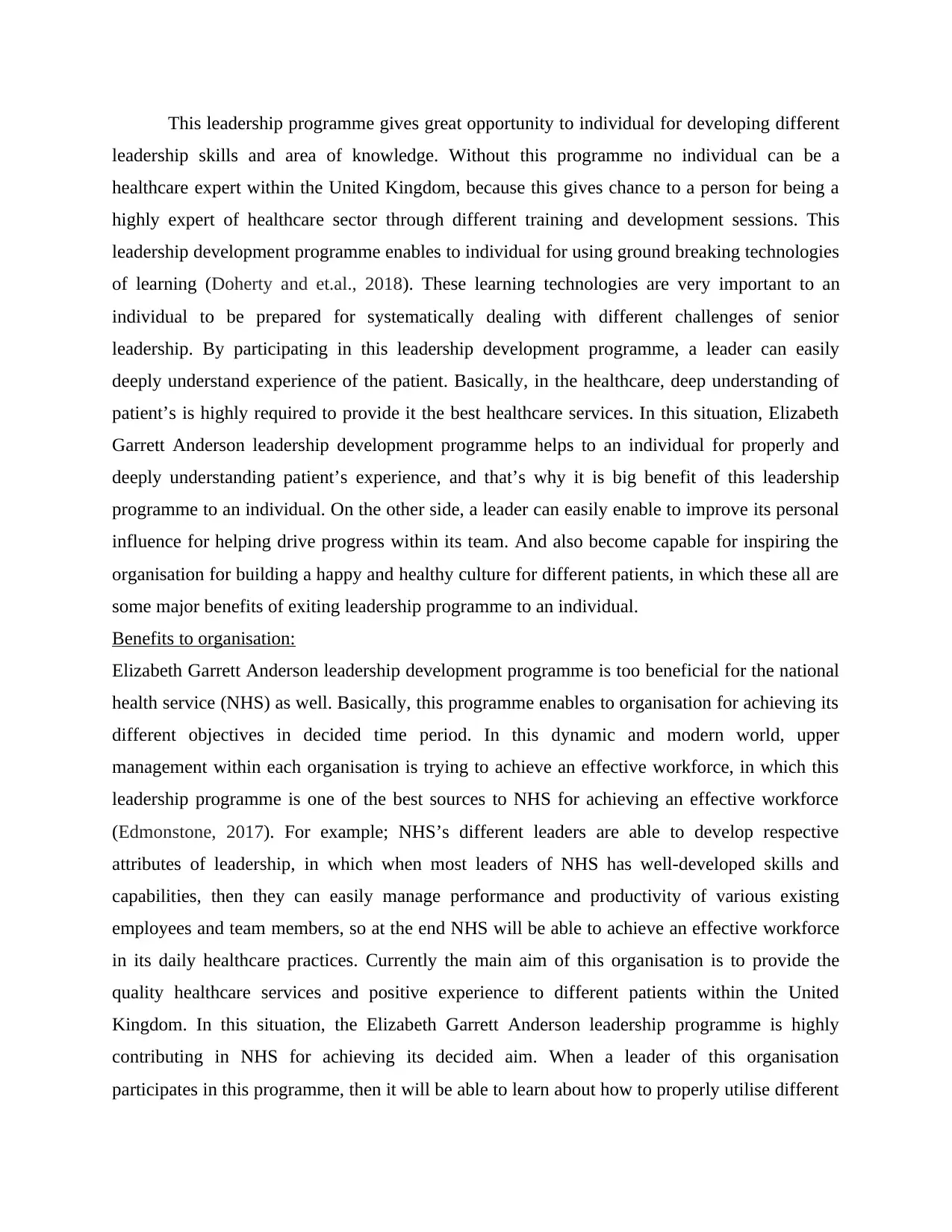
This leadership programme gives great opportunity to individual for developing different
leadership skills and area of knowledge. Without this programme no individual can be a
healthcare expert within the United Kingdom, because this gives chance to a person for being a
highly expert of healthcare sector through different training and development sessions. This
leadership development programme enables to individual for using ground breaking technologies
of learning (Doherty and et.al., 2018). These learning technologies are very important to an
individual to be prepared for systematically dealing with different challenges of senior
leadership. By participating in this leadership development programme, a leader can easily
deeply understand experience of the patient. Basically, in the healthcare, deep understanding of
patient’s is highly required to provide it the best healthcare services. In this situation, Elizabeth
Garrett Anderson leadership development programme helps to an individual for properly and
deeply understanding patient’s experience, and that’s why it is big benefit of this leadership
programme to an individual. On the other side, a leader can easily enable to improve its personal
influence for helping drive progress within its team. And also become capable for inspiring the
organisation for building a happy and healthy culture for different patients, in which these all are
some major benefits of exiting leadership programme to an individual.
Benefits to organisation:
Elizabeth Garrett Anderson leadership development programme is too beneficial for the national
health service (NHS) as well. Basically, this programme enables to organisation for achieving its
different objectives in decided time period. In this dynamic and modern world, upper
management within each organisation is trying to achieve an effective workforce, in which this
leadership programme is one of the best sources to NHS for achieving an effective workforce
(Edmonstone, 2017). For example; NHS’s different leaders are able to develop respective
attributes of leadership, in which when most leaders of NHS has well-developed skills and
capabilities, then they can easily manage performance and productivity of various existing
employees and team members, so at the end NHS will be able to achieve an effective workforce
in its daily healthcare practices. Currently the main aim of this organisation is to provide the
quality healthcare services and positive experience to different patients within the United
Kingdom. In this situation, the Elizabeth Garrett Anderson leadership programme is highly
contributing in NHS for achieving its decided aim. When a leader of this organisation
participates in this programme, then it will be able to learn about how to properly utilise different
leadership skills and area of knowledge. Without this programme no individual can be a
healthcare expert within the United Kingdom, because this gives chance to a person for being a
highly expert of healthcare sector through different training and development sessions. This
leadership development programme enables to individual for using ground breaking technologies
of learning (Doherty and et.al., 2018). These learning technologies are very important to an
individual to be prepared for systematically dealing with different challenges of senior
leadership. By participating in this leadership development programme, a leader can easily
deeply understand experience of the patient. Basically, in the healthcare, deep understanding of
patient’s is highly required to provide it the best healthcare services. In this situation, Elizabeth
Garrett Anderson leadership development programme helps to an individual for properly and
deeply understanding patient’s experience, and that’s why it is big benefit of this leadership
programme to an individual. On the other side, a leader can easily enable to improve its personal
influence for helping drive progress within its team. And also become capable for inspiring the
organisation for building a happy and healthy culture for different patients, in which these all are
some major benefits of exiting leadership programme to an individual.
Benefits to organisation:
Elizabeth Garrett Anderson leadership development programme is too beneficial for the national
health service (NHS) as well. Basically, this programme enables to organisation for achieving its
different objectives in decided time period. In this dynamic and modern world, upper
management within each organisation is trying to achieve an effective workforce, in which this
leadership programme is one of the best sources to NHS for achieving an effective workforce
(Edmonstone, 2017). For example; NHS’s different leaders are able to develop respective
attributes of leadership, in which when most leaders of NHS has well-developed skills and
capabilities, then they can easily manage performance and productivity of various existing
employees and team members, so at the end NHS will be able to achieve an effective workforce
in its daily healthcare practices. Currently the main aim of this organisation is to provide the
quality healthcare services and positive experience to different patients within the United
Kingdom. In this situation, the Elizabeth Garrett Anderson leadership programme is highly
contributing in NHS for achieving its decided aim. When a leader of this organisation
participates in this programme, then it will be able to learn about how to properly utilise different
⊘ This is a preview!⊘
Do you want full access?
Subscribe today to unlock all pages.

Trusted by 1+ million students worldwide
1 out of 15
Related Documents
Your All-in-One AI-Powered Toolkit for Academic Success.
+13062052269
info@desklib.com
Available 24*7 on WhatsApp / Email
![[object Object]](/_next/static/media/star-bottom.7253800d.svg)
Unlock your academic potential
Copyright © 2020–2025 A2Z Services. All Rights Reserved. Developed and managed by ZUCOL.





